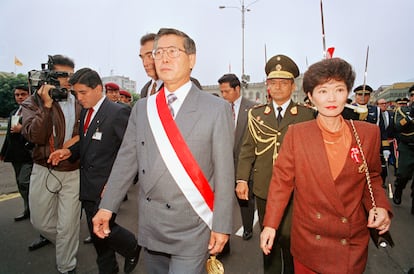US declassifies documents chronicling 20 years of conflict in Peru
The National Security Archive says the current political crisis ‘demonstrates that the problems and legacies of Peru’s violent past are still very present today’

What Peru suffered during the last two decades of the 20th century is still a matter of fervent discussion. It remains an open wound caused by an accumulation of bloody events that resulted in the death of 69,000 Peruvians and the disappearance of over 19,000 more. Families were broken apart in the middle of a crossfire that made the country unlivable. Twenty years have passed since the final report of the Truth and Reconciliation Commission (CVR), the most solid and concrete initiative to date on the part of the Peruvian state in its attempt to understand a tragic period where human rights were repeatedly violated. It was a titanic effort that must be acknowledged, despite not having unanimous support from the population.
On the occasion of this anniversary, the National Security Archive, a U.S. non-governmental organization that has worked to access confidential U.S. government documents for 38 years, has posted a collection of 22 cables and declassified intelligence reports dating from the days of the internal armed conflict in Peru. They are new pieces that will help put together the puzzle of a story that remains incomplete to this day.
The first documents show that the CIA’s National Foreign Assessment Center underestimated the terrorist group Shining Path (Sendero Luminoso) in the first five years of the 1980s to the point of assuming that they were only a minor threat to citizens and the government of Fernando Belaunde, while predicting that the army would easily destroy the insurgents. There is also a very revealing report by the U.S. State Department Bureau of Intelligence and Research Assessment dated October 3, 1984 that accurately predicted what later happened: “The armed forces do not appear capable of winning militarily and may be tempted to try physically annihilating Sendero Luminoso by eliminating everyone suspected of being a member or sympathizer.”
Another declassified document, dating from May 24, 1988, leaves Armando Villanueva del Campo, a long-standing politician of the Peruvian APRA Party, in a very bad light. The newly installed prime minister in the first administration of President Alan García met with high-level military officers and drafted a communiqué backing the military version that a massacre had not taken place at Cayara, Ayacucho. A week earlier, 39 people had gone missing in a community in the Ayacucho region in retaliation for an ambush that killed four soldiers. The event is known as the Cayara case.
According to the document, Villanueva “reportedly remarked that he did not care if the army executed every Sendero Luminoso guerrilla it captured as long as such executions were accomplished discreetly.” Moreover, he allegedly assured that any opposition investigation into the Cayara case “would be immediately defeated.” This month, 35 years later, the people of Cayara have found some justice: the individuals accused of the massacre were sentenced to between eight and 15 years in prison.
The hostage crisis at the residence of the Japanese ambassador in Lima, carried out by members of the Tupac Amaru Revolutionary Movement (MRTA), kept the country and the international community on tenterhooks from December 1996 to April 1997. But the exemplary strategy demonstrated by the military operation that achieved the release of the hostages was overshadowed by rumors of executions of the defeated terrorists. A cable by the U.S. Defense Intelligence Agency dated June 10, 1997, and based on unknown sources, recounts the extrajudicial execution of two MRTA members after they had surrendered at the end of the hostage crisis, and states that “the order to take no MRTA alive was given by President Alberto Fujimori.”
According to the NSA, “The message describes how one of the military commandos in the rescue operation recognized MRTA member Roli Rojas (“El Arabe”) among the hostages being led out of the residence, detained him, took him into the house, and shot him in the head. He then placed his body next to the fallen MRTA leader Nestor Cerpa, who had been killed during the crossfire. The cable also notes that a female MRTA member was executed after surrendering to security forces..”
Another confidential cable from April 18, 1997 provides details on the murder, dismemberment and decapitation of Army Intelligence Service (SIE) agent Mariela Barreto, said the NSA. Barreto was killed by her former colleagues from the La Colina death squad, a paramilitary group. Last June, Alberto Fujimori’s presidential adviser, Vladimiro Montesinos, was sentenced to 23 years in prison when it was determined that he was behind the crime, using someone else as a tool to perpetrate it.
In a U.S. Embassy cable dated August 27, 2003, on the eve of the original release of the CVR’s final report, an embassy officer wrote that the ultimate goals of the document were “to encourage Peruvians to confront their country’s recent violent past, come to terms with what occurred, and take the necessary measures to ensure that history does not repeat itself.” But the NSA notes that the current political crisis in Peru, where the government of Dina Boluarte faces a wave of popular protests, “demonstrates that the problems and legacies of Peru’s violent past are still very present today.”
Sign up for our weekly newsletter to get more English-language news coverage from EL PAÍS USA Edition
Tu suscripción se está usando en otro dispositivo
¿Quieres añadir otro usuario a tu suscripción?
Si continúas leyendo en este dispositivo, no se podrá leer en el otro.
FlechaTu suscripción se está usando en otro dispositivo y solo puedes acceder a EL PAÍS desde un dispositivo a la vez.
Si quieres compartir tu cuenta, cambia tu suscripción a la modalidad Premium, así podrás añadir otro usuario. Cada uno accederá con su propia cuenta de email, lo que os permitirá personalizar vuestra experiencia en EL PAÍS.
¿Tienes una suscripción de empresa? Accede aquí para contratar más cuentas.
En el caso de no saber quién está usando tu cuenta, te recomendamos cambiar tu contraseña aquí.
Si decides continuar compartiendo tu cuenta, este mensaje se mostrará en tu dispositivo y en el de la otra persona que está usando tu cuenta de forma indefinida, afectando a tu experiencia de lectura. Puedes consultar aquí los términos y condiciones de la suscripción digital.
More information
Archived In
Últimas noticias
The new victims of the Republican war on Obamacare: Millions hit by soaring health insurance premiums
A country divided on migrant rights: Some US states expand protections while others restrict them
Venezuela authorizes the release of another 87 political prisoners
There is as much life left to discover on planet Earth as that which is already known
Most viewed
- David King, chemist: ‘There are scientists studying how to cool the planet; nobody should stop these experiments from happening’
- Reinhard Genzel, Nobel laureate in physics: ‘One-minute videos will never give you the truth’
- Oona Chaplin: ‘I told James Cameron that I was living in a treehouse and starting a permaculture project with a friend’
- Sinaloa Cartel war is taking its toll on Los Chapitos
- The Interoceanic Train, the Mexican alternative to the Panama Canal










































